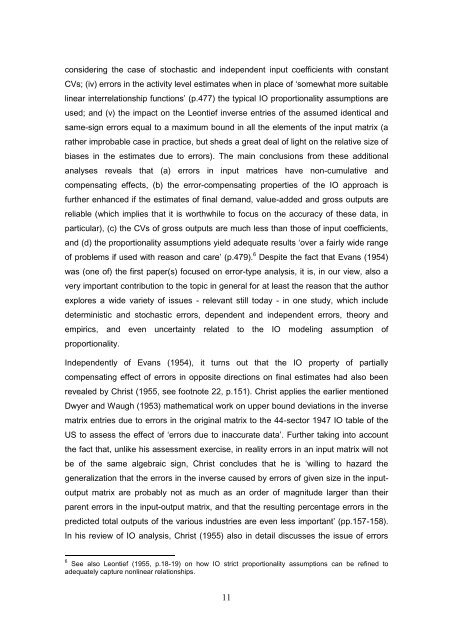Uncertainty treatment in input-output analysis
ifDakU
ifDakU
Create successful ePaper yourself
Turn your PDF publications into a flip-book with our unique Google optimized e-Paper software.
consider<strong>in</strong>g the case of stochastic and <strong>in</strong>dependent <strong>in</strong>put coefficients with constant<br />
CVs; (iv) errors <strong>in</strong> the activity level estimates when <strong>in</strong> place of „somewhat more suitable<br />
l<strong>in</strong>ear <strong>in</strong>terrelationship functions‟ (p.477) the typical IO proportionality assumptions are<br />
used; and (v) the impact on the Leontief <strong>in</strong>verse entries of the assumed identical and<br />
same-sign errors equal to a maximum bound <strong>in</strong> all the elements of the <strong>in</strong>put matrix (a<br />
rather improbable case <strong>in</strong> practice, but sheds a great deal of light on the relative size of<br />
biases <strong>in</strong> the estimates due to errors). The ma<strong>in</strong> conclusions from these additional<br />
analyses reveals that (a) errors <strong>in</strong> <strong>in</strong>put matrices have non-cumulative and<br />
compensat<strong>in</strong>g effects, (b) the error-compensat<strong>in</strong>g properties of the IO approach is<br />
further enhanced if the estimates of f<strong>in</strong>al demand, value-added and gross <strong>output</strong>s are<br />
reliable (which implies that it is worthwhile to focus on the accuracy of these data, <strong>in</strong><br />
particular), (c) the CVs of gross <strong>output</strong>s are much less than those of <strong>in</strong>put coefficients,<br />
and (d) the proportionality assumptions yield adequate results „over a fairly wide range<br />
of problems if used with reason and care‟ (p.479). 6 Despite the fact that Evans (1954)<br />
was (one of) the first paper(s) focused on error-type <strong>analysis</strong>, it is, <strong>in</strong> our view, also a<br />
very important contribution to the topic <strong>in</strong> general for at least the reason that the author<br />
explores a wide variety of issues - relevant still today - <strong>in</strong> one study, which <strong>in</strong>clude<br />
determ<strong>in</strong>istic and stochastic errors, dependent and <strong>in</strong>dependent errors, theory and<br />
empirics, and even uncerta<strong>in</strong>ty related to the IO model<strong>in</strong>g assumption of<br />
proportionality.<br />
Independently of Evans (1954), it turns out that the IO property of partially<br />
compensat<strong>in</strong>g effect of errors <strong>in</strong> opposite directions on f<strong>in</strong>al estimates had also been<br />
revealed by Christ (1955, see footnote 22, p.151). Christ applies the earlier mentioned<br />
Dwyer and Waugh (1953) mathematical work on upper bound deviations <strong>in</strong> the <strong>in</strong>verse<br />
matrix entries due to errors <strong>in</strong> the orig<strong>in</strong>al matrix to the 44-sector 1947 IO table of the<br />
US to assess the effect of „errors due to <strong>in</strong>accurate data‟. Further tak<strong>in</strong>g <strong>in</strong>to account<br />
the fact that, unlike his assessment exercise, <strong>in</strong> reality errors <strong>in</strong> an <strong>in</strong>put matrix will not<br />
be of the same algebraic sign, Christ concludes that he is „will<strong>in</strong>g to hazard the<br />
generalization that the errors <strong>in</strong> the <strong>in</strong>verse caused by errors of given size <strong>in</strong> the <strong>in</strong>put<strong>output</strong><br />
matrix are probably not as much as an order of magnitude larger than their<br />
parent errors <strong>in</strong> the <strong>in</strong>put-<strong>output</strong> matrix, and that the result<strong>in</strong>g percentage errors <strong>in</strong> the<br />
predicted total <strong>output</strong>s of the various <strong>in</strong>dustries are even less important‟ (pp.157-158).<br />
In his review of IO <strong>analysis</strong>, Christ (1955) also <strong>in</strong> detail discusses the issue of errors<br />
6 See also Leontief (1955, p.18-19) on how IO strict proportionality assumptions can be ref<strong>in</strong>ed to<br />
adequately capture nonl<strong>in</strong>ear relationships.<br />
11


